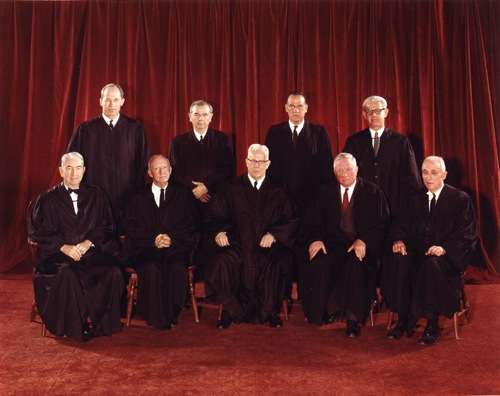The Contraception Mandate litigation is the Jarndyce v. Jarndyce of church-state cases: a lawsuit, or, rather, collection of lawsuits, that seems to go on and on without ever reaching an end. True, unlike the Bleak House original, the Contraception Mandate litigation isn’t making anybody rich. But in its capacity to draw in numerous parties and lawyers and maintain its place on the Supreme Court docket for years, the litigation does seem a bit Dickensian.
The litigation began in 2011, when the Obama Administration promulgated regulations under the Affordable Care Act that required employers to cover contraceptives, cost-free, in their employee health plans. The Obama Administration exempted churches from the Mandate and, after it received complaints, grudgingly offered religious non-profits an “accommodation.” A religious non-profit could avoid the Mandate, and forgo covering contraceptives in its plan, if it filed a form indicating that it objected to covering contraceptives as a matter of religious principle, in which case the plan’s provider would have to cover the contraceptives itself, without cost to employer or employee.
Neither the exemption nor the accommodation applied to for-profit corporations. Nonetheless, in Burwell v. Hobby Lobby (2014), the Court ruled that the government must grant an accommodation to closely held, for-profit corporations that objected to covering contraceptives for religious reasons. The Court did so under the Religious Freedom Restoration Act (RFRA), which provides that the government cannot substantially burden a person’s exercise of religion unless the government has a compelling reason for doing so and has chosen the least-restrictive means. Requiring a closely held corporation to cover contraceptives would violate RFRA, the Court held, since a less-restrictive alternative was available. The government could offer for-profits the accommodation it offered religious non-profits—submit a form and have your plan’s provider cover the contraceptives—which would achieve the government’s interest in ensuring access to cost-free contraceptives without infringing on employers’ religious freedom.
Meanwhile, in a separate litigation, some religious non-profits were challenging the accommodation itself. These parties, including a Catholic order called the Little Sisters of the Poor, argued that the accommodation itself violated their religious freedom, since, by submitting the required forms to their plan providers, they would still be complicit in the act of offering contraceptives to their employees, an act they considered gravely immoral. As a matter of religious conviction, they maintained, they could not participate, even indirectly, in such plans.
This litigation also reached the Supreme Court, in a 2016 case called Zubik v. Burwell, in which the Court took a rather unusual step. Rather than reach a decision on the merits, the Court remanded the case and directed the lower court to give the parties another chance to settle their dispute, since the parties’ positions were, as a practical matter, not so far apart. Religious non-profits would not object if their insurance providers offered contraceptives through independent plans, and the government admitted that this arrangement would achieve the objective of providing women with contraceptives cost-free. The solution to the dispute seemed obvious.
That’s where things stood when the presidential election of 2016 brought a new administration to power. Elections have consequences. The Trump Administration
wrote new regulations that extended the exemption for churches to religious non-profits like the Little Sisters. Under the new regulations, religious non-profits, like churches, were no longer subject to the Mandate.
One might have thought that would bring the Mandate litigation to an end. It did not. The Commonwealth of Pennsylvania now sued, arguing that the federal government lacked authority to issue the new regulations, either under the Administrative Procedure Act or under RFRA. The Little Sisters of the Poor then sought to intervene to defend the new regulations. The litigation continued, with the parties having switched roles. Religious non-profits now found themselves on the side of the federal government.
This new case, Little Sisters of the Poor v. Pennsylvania, is now before the Supreme Court, on cert from the Third Circuit. The case presents a few complicated issues, including questions about state standing, appellate standing, administrative procedure, and nationwide injunctions. The case also raises an interesting, and new, RFRA issue. In the current case, the question is not whether RFRA requires the federal government to grant an accommodation. The question is whether RFRA allows the federal government to grant an accommodation broader than the one the Court already has authorized. As Kevin Walsh observes in a recent Legal Spirits podcast, this is a question with potentially big implications for church-state law.
Why does the Mandate litigation go on and on? As I said, it’s not a question of money. Lawyers are not getting rich on these cases. The litigation continues because people care deeply, as a matter of principle, about the result, and because each side views the other as an existential threat. For proponents of the Mandate, it’s about women’s health and equality, and about beating back the obscurantist forces that threaten both. For opponents, it’s about affirming their deepest faith commitments, notwithstanding pressure from the state and progressive opinion that seeks to crush them. Even when a practical solution seems available—as the Court noted in Zubik—the parties find it difficult to compromise. The symbolic stakes are too high.
In short, the Contraception Mandate litigation, like so many other disputes over law and religion, reflects the deep polarization in our society. As long as that polarization continues, cases like Hobby Lobby, Zubik, and Little Sisters will continue to arise—as well as cases like Masterpiece Cakeshop, Fulton v. City of Philadelphia, and many others.
The Court was supposed to hear the Little Sisters case this month, but postponed argument because of the coronavirus epidemic. The Court will decide the case at some point in the future. When the Court does issue its ultimate decision, whenever that occurs and however the Court rules, that should end the Contraception Mandate litigation once-and-for-all, right? What could remain be decided?
Don’t count on it.
from Latest – Reason.com https://ift.tt/3bLKXTU
via IFTTT
 The critical indifference to this high-school horror-comedy was baffling. (It scored a rotten 44% on Rotten Tomatoes.) Diablo Cody’s screenplay—a marvel of sexy sarcasm—was the follow-up to her debut script for the 2007 hit Juno (whose director, Jason Reitman, is one of the producers here). And the star, Megan Fox, of the mega-budget Transformers franchise, delivered a luscious parody of her own sex-puppet image. Fox plays the titular Jennifer, a snooty cheerleader who falls into the clutches of an indie band called Low Shoulder, whose members are desperate to make it big and have decided to sacrifice a virgin in order to enlist Satan as their manager. Unfortunately, since Jennifer is not a virgin in any sense of the word, the band’s attempted ritual goes wildly awry and a newly demonic Jennifer is soon embarked on a bloody rampage. Amanda Seyfried effectively mutes her own movie-star looks to play Jennifer’s geeky friend Needy, and Chris Pratt, Amy Sedaris and J.K. Simmons are also on hand. (Now streaming on Amazon, YouTube, iTunes, etc.)
The critical indifference to this high-school horror-comedy was baffling. (It scored a rotten 44% on Rotten Tomatoes.) Diablo Cody’s screenplay—a marvel of sexy sarcasm—was the follow-up to her debut script for the 2007 hit Juno (whose director, Jason Reitman, is one of the producers here). And the star, Megan Fox, of the mega-budget Transformers franchise, delivered a luscious parody of her own sex-puppet image. Fox plays the titular Jennifer, a snooty cheerleader who falls into the clutches of an indie band called Low Shoulder, whose members are desperate to make it big and have decided to sacrifice a virgin in order to enlist Satan as their manager. Unfortunately, since Jennifer is not a virgin in any sense of the word, the band’s attempted ritual goes wildly awry and a newly demonic Jennifer is soon embarked on a bloody rampage. Amanda Seyfried effectively mutes her own movie-star looks to play Jennifer’s geeky friend Needy, and Chris Pratt, Amy Sedaris and J.K. Simmons are also on hand. (Now streaming on Amazon, YouTube, iTunes, etc.) Crawling back from one of the most widely detested debuts in recent film history—the 1993 amputation oddity Boxing Helena—director Jennifer Lynch (daughter of David) made this seriously creepy serial-killer feature. Bill Pullman and Julia Ormond play a pair of FBI agents drawn to a slaughter site in the Nebraska hinterlands, where they interact with bent cops and druggy youths and search in vain for reliable witnesses. (There is one, but she’s 11 years old, and who wants to hear what a kid has to say?) The movie has a bleak, sunbaked vibe and a most unsettling conclusion. It scored a limp 55% on Rotten Tomatoes and has yet to attract many second looks. It’s never too late, though. (Now streaming on Amazon and Netflix)
Crawling back from one of the most widely detested debuts in recent film history—the 1993 amputation oddity Boxing Helena—director Jennifer Lynch (daughter of David) made this seriously creepy serial-killer feature. Bill Pullman and Julia Ormond play a pair of FBI agents drawn to a slaughter site in the Nebraska hinterlands, where they interact with bent cops and druggy youths and search in vain for reliable witnesses. (There is one, but she’s 11 years old, and who wants to hear what a kid has to say?) The movie has a bleak, sunbaked vibe and a most unsettling conclusion. It scored a limp 55% on Rotten Tomatoes and has yet to attract many second looks. It’s never too late, though. (Now streaming on Amazon and Netflix) Darren Aronofsky’s time-tripping masterwork was seen by some—well, many—as a pretentious romance. But it’s a spectacularly beautiful film that has steadily accumulated new admirers. Hugh Jackman and Rachel Weisz play Tom and Isabel, a couple whose love never dies. In 16th Century Spain, she is a queen dispatching him on a mission to the New World to find the Mayan tree of life. 500 years later—now—he is a research scientist searching for a cure for the cancer that is killing Isabel, who in this incarnation is his wife. He learns of an ancient tree in Central America whose bark may be the cure he seeks. In the year 2600 AD, we find Tom ascending through the heavens in a transparent bubble-ship containing a large tree. The glorious outer-space effects in this film are super-size blowups of microscopic chemical reactions (the work of optical-systems developer Peter Parks) and the magnificent score, by Clint Mansell, could become a permanent part of your life. (Streaming on Amazon, YouTube and Vudu)
Darren Aronofsky’s time-tripping masterwork was seen by some—well, many—as a pretentious romance. But it’s a spectacularly beautiful film that has steadily accumulated new admirers. Hugh Jackman and Rachel Weisz play Tom and Isabel, a couple whose love never dies. In 16th Century Spain, she is a queen dispatching him on a mission to the New World to find the Mayan tree of life. 500 years later—now—he is a research scientist searching for a cure for the cancer that is killing Isabel, who in this incarnation is his wife. He learns of an ancient tree in Central America whose bark may be the cure he seeks. In the year 2600 AD, we find Tom ascending through the heavens in a transparent bubble-ship containing a large tree. The glorious outer-space effects in this film are super-size blowups of microscopic chemical reactions (the work of optical-systems developer Peter Parks) and the magnificent score, by Clint Mansell, could become a permanent part of your life. (Streaming on Amazon, YouTube and Vudu) This second feature by Knives Out director Rian Johnson is an eccentric fairy tale of overflowing charm. A pair of sibling conmen (Adrien Brody and Mark Ruffalo) make the mistake of trying to swindle a wacky heiress (Rachel Weisz), who numbers among her hobbies kung fu, power ping pong, and chainsaw juggling (on stilts), and who would love to become a swindler herself. The picture flits all around Central Europe, but even with the brothers bringing in a daffy explosives expert called Bang Bang (Rinko Kikuchi), we sense that the big con they’ve planned, in Prague, will not be working out well. They should have sensed something amiss when their mark observed, “The trick to not being cheated is to learn how to cheat.” (Streaming on Amazon and Vudu)
This second feature by Knives Out director Rian Johnson is an eccentric fairy tale of overflowing charm. A pair of sibling conmen (Adrien Brody and Mark Ruffalo) make the mistake of trying to swindle a wacky heiress (Rachel Weisz), who numbers among her hobbies kung fu, power ping pong, and chainsaw juggling (on stilts), and who would love to become a swindler herself. The picture flits all around Central Europe, but even with the brothers bringing in a daffy explosives expert called Bang Bang (Rinko Kikuchi), we sense that the big con they’ve planned, in Prague, will not be working out well. They should have sensed something amiss when their mark observed, “The trick to not being cheated is to learn how to cheat.” (Streaming on Amazon and Vudu) A wonderfully nutty tribute to ’70s blaxploitation movies. Michael Jai White is perfect as the titular Black Dynamite, a CIA operative just back from Vietnam who is intent on terminating some evil honkeys who are funneling heroin into the ghetto. There’s also a worrisome new brand of malt liquor that’s hit the streets, an array of pimps and pushers and vintage purple clothing, ultra-low-budget martial-arts and car-chase action, and a ridiculous crime lord called Fiendish Dr. Wu. There are also many great lines (scoping out B.D.’s deluxe pad, one character says, “You must have an eight-track in every room”). Director Scott Sanders shot this movie in three weeks (and later turned it into an animated series on Adult Swim). He should be working a lot more than he does. (Streaming on Amazon, Netflix, and Vudu)
A wonderfully nutty tribute to ’70s blaxploitation movies. Michael Jai White is perfect as the titular Black Dynamite, a CIA operative just back from Vietnam who is intent on terminating some evil honkeys who are funneling heroin into the ghetto. There’s also a worrisome new brand of malt liquor that’s hit the streets, an array of pimps and pushers and vintage purple clothing, ultra-low-budget martial-arts and car-chase action, and a ridiculous crime lord called Fiendish Dr. Wu. There are also many great lines (scoping out B.D.’s deluxe pad, one character says, “You must have an eight-track in every room”). Director Scott Sanders shot this movie in three weeks (and later turned it into an animated series on Adult Swim). He should be working a lot more than he does. (Streaming on Amazon, Netflix, and Vudu) Released at the dawn of the cinematic superhero age (the same year Iron Man inaugurated the MCU), Hancock appeared to confuse critics with its relatively subtle combination of underplayed humor and real emotion. Despite the presence of Will Smith and Charlize Theron, the movie bombed. It deserves another chance. Smith plays a super-guy called John Hancock, who has the usual powers of flight, strength, and immortality. John does a lot of good in the world, but he also causes a lot of collateral property damage, for which he is widely resented. So he’s basically become an alcoholic living on the streets of LA. An admiring PR man named Ray (Jason Bateman) tries to help him and does; but then John meets Ray’s wife (Charlize Theron), and the movie takes a sudden turn into wild and unexpected territory. Very much worth taking a chance on. (Streaming on Amazon, Netflix, and Vudu)
Released at the dawn of the cinematic superhero age (the same year Iron Man inaugurated the MCU), Hancock appeared to confuse critics with its relatively subtle combination of underplayed humor and real emotion. Despite the presence of Will Smith and Charlize Theron, the movie bombed. It deserves another chance. Smith plays a super-guy called John Hancock, who has the usual powers of flight, strength, and immortality. John does a lot of good in the world, but he also causes a lot of collateral property damage, for which he is widely resented. So he’s basically become an alcoholic living on the streets of LA. An admiring PR man named Ray (Jason Bateman) tries to help him and does; but then John meets Ray’s wife (Charlize Theron), and the movie takes a sudden turn into wild and unexpected territory. Very much worth taking a chance on. (Streaming on Amazon, Netflix, and Vudu) Although he’d already made one feature in 2000—the distinctively gruesome sci-fi horror film The Cell—Indian director Tarsem Singh continued earning most of his living shooting commercials. Kind of brilliantly, he decided to utilize the globe-trotting required by this profession to make another movie, on his own dime. This resulted, after four years, in The Fall, an extremely outré and astoundingly beautiful fantasy film shot in Cambodia, Italy, Indonesia, Bolivia and China, among other far-flung places. It’s a movie about stories and their telling and the heroes they require; but essentially it’s a vast sea of surreal imagery into which viewers are invited to sink their heads. There truly is nothing else like it. (Streaming on Netflix and Amazon)
Although he’d already made one feature in 2000—the distinctively gruesome sci-fi horror film The Cell—Indian director Tarsem Singh continued earning most of his living shooting commercials. Kind of brilliantly, he decided to utilize the globe-trotting required by this profession to make another movie, on his own dime. This resulted, after four years, in The Fall, an extremely outré and astoundingly beautiful fantasy film shot in Cambodia, Italy, Indonesia, Bolivia and China, among other far-flung places. It’s a movie about stories and their telling and the heroes they require; but essentially it’s a vast sea of surreal imagery into which viewers are invited to sink their heads. There truly is nothing else like it. (Streaming on Netflix and Amazon) Will Stronghold (Michael Angarano) is a teenager living in the large shadow of his superhero parents. His father, Steve (Kurt Russell), is a successful real estate guy better known in super-circles as The Commander; his mom, Josie (Kelly Preston), is the famously supersonic Jetstream. Will doesn’t seem to have any powers of his own, so he’s apprehensive about entering ninth grade at Sky High, where superhero offspring are sorted into two categories: some will become superheroes themselves, others—the losers in life’s super-lottery—will become sidekicks. This is a Disney film, and thus family-friendly, but it’s also witty and hip (thanks mainly to Russell, a Disney veteran who made his first movie for the company in 1968). Mary Elizabeth Winstead plays the villainous Royal Pain and the principal at Sky High, wonderfully enough, is Lynda Carter. (Streaming on Amazon and Vudu)
Will Stronghold (Michael Angarano) is a teenager living in the large shadow of his superhero parents. His father, Steve (Kurt Russell), is a successful real estate guy better known in super-circles as The Commander; his mom, Josie (Kelly Preston), is the famously supersonic Jetstream. Will doesn’t seem to have any powers of his own, so he’s apprehensive about entering ninth grade at Sky High, where superhero offspring are sorted into two categories: some will become superheroes themselves, others—the losers in life’s super-lottery—will become sidekicks. This is a Disney film, and thus family-friendly, but it’s also witty and hip (thanks mainly to Russell, a Disney veteran who made his first movie for the company in 1968). Mary Elizabeth Winstead plays the villainous Royal Pain and the principal at Sky High, wonderfully enough, is Lynda Carter. (Streaming on Amazon and Vudu) Originally released with an NC-17 rating because of its unusually forthright sex scenes, this intricately noirish film by writer-director Atom Egoyan is a puzzle-thriller that deserves more attention than it has ever received. It focuses on Lanny Morris (Kevin Bacon) and Vince Collins (Colin Firth), a famous comedy duo (think Dean Martin and Jerry Lewis) who suddenly broke up in 1957, with no explanation, after a dead Miami woman’s body was found in the bathtub of their New Jersey hotel suite. Years later, a young journalist named Karen O’Connor (Alison Lohman) agrees to work with Vince as a ghostwriter on his autobiography, hoping to get to the bottom of the breakup mystery. Then she encounters Lanny, and things get very, very complicated. The movie has a wonderful retro-kinky air, and Bacon and Firth are bracingly unsavory in ways they had never been before. (Streaming on Amazon and Vudu)
Originally released with an NC-17 rating because of its unusually forthright sex scenes, this intricately noirish film by writer-director Atom Egoyan is a puzzle-thriller that deserves more attention than it has ever received. It focuses on Lanny Morris (Kevin Bacon) and Vince Collins (Colin Firth), a famous comedy duo (think Dean Martin and Jerry Lewis) who suddenly broke up in 1957, with no explanation, after a dead Miami woman’s body was found in the bathtub of their New Jersey hotel suite. Years later, a young journalist named Karen O’Connor (Alison Lohman) agrees to work with Vince as a ghostwriter on his autobiography, hoping to get to the bottom of the breakup mystery. Then she encounters Lanny, and things get very, very complicated. The movie has a wonderful retro-kinky air, and Bacon and Firth are bracingly unsavory in ways they had never been before. (Streaming on Amazon and Vudu)